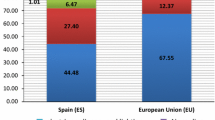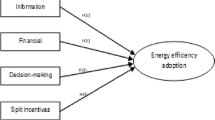Abstract
Residential energy efficiency improvements have a great potential to reduce greenhouse gas (GHG) emissions. Evidences suggest that there is an underinvestment in residential energy efficiency improvements, pointing out the existence of “energy efficiency gap”. To address this in Canada, the government has introduced home energy efficiency audit programmes since 1998, to encourage homeowners to get their homes audited professionally for energy efficiency and implement recommended upgrades. Using the 2011 and 2013 Household and Environment Surveys, this paper investigates whether household environmental behaviours have played roles in determining household participation in these audit programmes during the last 10 years. To the best of our knowledge, no study in Canada has examined the association between household participation in other pro-environmental activities and energy efficiency audit programmes. We find that pro-environmental behaviours such as water conservation, composting, recycling, participation in unpaid conservation activities, purchase of green goods, carrying own grocery shopping bags and lowering heating temperatures in winter nights are good predictors of household participation in energy efficiency audit programmes. Given that these other pro-environmental activities demonstrate environmental awareness of the households, our results suggest that besides the financial incentives, a more strategic and holistic approach to environmental programmes is both needed and possible when designing policies addressing residential energy efficiency gap.

Similar content being viewed by others
Notes
The data included payments made in 2013 although the financial incentive programme was in place only up to end of 2017. This is because homeowners have up to 18 months, after the initial audit, to implement the recommended upgrades and submit application for rebates after having a second audit that confirms the improvements.
These figures do not include the amounts disbursed before 2007 under the preceding programme known as EnerGuide for houses. The figures are based on summary of incentive payment reports obtained from Natural Resources Canada.
The figures are based on summary of incentive payment reports obtained from Natural Resources Canada.
Generally, pro-environmental behaviours refer to “purchase choice, product use and post-use, household management, collective, and consumer activism behaviors, reflecting some degree of environment-related motivation” (Peattie 2010).
This statement refers to studies that are specifically using data on programmes involving energy efficiency audits. However, there are a number of studies that utilize data from participation in utility sponsored demand side management programmes not involving audits (e.g. Hartman 1988; Joskow and Marron 1992; Eto et al. 1996).
Stated preference data are collected in experimental or survey situations where respondents are presented with hypothetical choice situations.
The two programmes are identical despite the differences in their names, particularly in terms of the requirement to get pre- and post-retrofit audits by certified professionals as well as the sliding scale of energy savings associated with the undertaken upgrades applied in determining the amounts of rebates that each participant is eligible based on completion of the recommended upgrades.
In the combined 2011 and 2013 HES dataset, about 72% of those who reported having home energy efficiency audits during the past 10 years had made changes due to the audits.
Generally, modelling actual upgrades rather than the intensions to upgrade expressed through first audit would be difficult in the absence of information about the net financial gains (the upfront costs of the upgrades accounting for the potential flow of resulting energy cost savings). Despite having the intentions, potential net financial gains are the ultimate constraints for implementing the recommended upgrades and their omission in the regression model would cause severe omitted variables bias.
It should be noted that the purchase of energy efficiency bulbs is subsidized in some provinces. For instance, in Saskatchewan, SaskPower partners with local retailers, twice a year, to offer discounts on a variety of energy-efficient lighting products, including CFL and LED bulbs.
Testing for the equality of coefficients on the lower income and lower education categories indicated that they could be aggregated.
On the other hand, this could be related to free ridership on government subsidy for energy efficiency activity, which is measured based on the difference between household willingness to pay for the upgrades and the costs of energy efficiency retrofits (Alberini et al. 2016; Eto et al. 1996; Grösche and Vance 2009; Grösche et al. 2009; Joskow and Marron 1992). Accordingly, the percentage of the recipients of government subsidy for whom their willingness to pay exceeds the costs of the upgrades determine the percentage of the free-riders among the recipients.
Authors’ calculations based on database available online at http://oee.nrcan.gc.ca/corporate/statistics/neud/dpa/showTable.cfm?type=CP§or=res&juris=ca&rn=27&page=0
Natural gas furnaces account for about 80% in Saskatchewan, 65% in Ontario, 50% in Manitoba and British Columbia, while the figure for Canada is 75%. The main heating energy sources in Atlantic Provinces are electricity (40%) followed by propane (32%).
References
Alberini, A., Banfi, S., & Ramseier, C. (2013). Energy efficiency investments in the home: Swiss homeowners and expectations about future energy prices. The Energy Journal, 34(1), 49–86.
Alberini, A., Gans, W., & Towe, C. (2016). Free riding, upsizing, and energy efficiency incentives in Maryland homes. The Energy Journal, 37(1), 259–290.
Amelia, N., & Brandt, N. (2015). Determinants of households’ investment in energy efficiency and renewables. Evidence from the OECD survey on household environmental behaviour and attitudes. Green Growth Knowledge Platform (GGKP). http://www.greengrowthknowledge.org/sites/default/files/Ameli_Determinants_of_households_investment_in_energy_efficiency_and_renewables.pdf Accessed January 2016.
Anderson, S. T., & Newell, R. G. (2004). Information programmes for technology adoption: the case of energy-efficiency audits. Resource and Energy Economics, 26(1), 27–50.
Banfi, S., Farsi, M., Filippini, M., & Jakob, M. (2008). Willingness to pay for energy-saving measures in residential buildings. Energy Economics, 30(2), 503–516.
Brown, M. A. (2001). Market failures and barriers as a basis for clean energy policies. Energy Policy, 29(14), 1197–1207.
Cameron, T. (1985). A nested logit model of energy conservation activity by owners of existing single family dwellings. The Review of Economics and Statistics, 67(2), 205–211.
Cameron, C., & Trivedi, P. K. (2010). Microeconometrics using Stata. Texas: Stata Press.
Collins, M., & Curtis, J. (2016). An examination of energy efficiency retrofit depth in Ireland. Energy and Buildings, 127, 170–182.
Das, R., Richman, R., & Brown, C. (2018). Demographic determinants of Canada’s households’ adoption of energy efficiency measures: observations from the households and environment survey. Energy Efficiency, 11(2), 465–482.
David Redmond and Associates (2009). Review of federal and provincial/territorial government grant and incentive programmes for homes renovations to increase energy efficiency; Prepared for the Canadian home builders’ association. (received through personal communication from author, August 15, 2016).
Dubin, J. (1986). A nested logit model of space and water heat system choice. Marketing Science, 5(2), 112–124.
Dubin, J., & McFadden, D. L. (1984). An econometric analysis of residential electric appliance holdings and consumption. Econometrica, 52(2), 345–362.
Eto, J., Vine, E., Shown, L., Sonnenblick, R., & Payne, C. (1996). The total cost and measured performance of utility-sponsored energy efficiency programmes. The Energy Journal, 17(1), 31–51.
Fernandez, V. P. (2001). Observable and unobservable determinants of replacement of home appliances. Energy Economics, 23(3), 305–323.
Frondel, M., & Vance, C. (2013). Heterogeneity in the effect of home energy audits: theory and evidence. Environmental and Resource Economics, 55(3), 407–418.
Gamtessa, S., & Ryan, D.L. (2007). Utilization of residential energy-saving retrofit programmes in Canada: who, what and why. Energy markets and sustainability in a larger Europe, 9th IAEE European conference, June 10–31, 2007. International Association for Energy Economics.
Gamtessa, S. F. (2013). An explanation of residential energy-efficiency retrofit behavior in Canada. Energy and Buildings, 57, 155–164.
Gillingham, K., Newell, R. G., & Palmer, K. (2009). Energy efficiency economics and policy. Annual Review of Resource Economics, 1, 597–620.
Gillingham, K., & Palmer, K. (2014). Bridging the energy efficiency gap: policy insights from economic theory and empirical evidence. Review of Environmental Economics and Policy, 8(1), 18–38.
Grösche, P., & Vance, C. (2009). Willingness to pay for energy conservation and free-ridership on subsidization: evidence from Germany. The Energy Journal, 30(2), 135–153.
Grösche, P., Schmidt, C. M., & Vance, C. (2009). Identifying free-riding in energy-conservation programmes using revealed preference data. Journal of Economics and Statistics. https://doi.org/10.1515/jbnst-2013-5-604.
Green Budget Coalition (2016). Recommendations for budget 2016: energy efficiency. http://greenbudget.ca/wp-content/uploads/2016/01/GBC-Efficiency.pdf Accessed July 2016.
Hartman, R. (1988). Self-selection bias in the evolution of voluntary energy conservation programmes. The Review of Economics and Statistics, 70(3), 448–458.
Hausman, J. (1979). Individual discount rates and the purchase of energy using durables. The Bell Journal of Economics, 10(1), 33–54.
Hoicka, C. E., & Parker, P. (2011). Residential energy efficiency programmes, retrofit choices and greenhouse gas emissions savings: a decade of energy efficiency improvements in waterloo region, Canada. International Journal of Energy Research, 35(15), 1312–1324.
Hoicka, C. E., Parker, P., & Andrey, J. (2014). Residential energy efficiency retrofits: how program design affects participation and outcomes. Energy Policy, 65, 594–607.
Hoicka, C. E., & Parker, P. (2018). Assessing the adoption of the house as a system approach to residential energy efficiency programmes. Energy Efficiency, 11(2), 295–313.
Jakob, M. (2006). Marginal costs and co-benefits of energy efficiency investments: the case of the Swiss residential sector. Energy Policy, 34(2), 172–187.
Joskow, P. L., & Marron, D. B. (1992). What does a negawatt really cost? Evidence from utility conservation programmes. The Energy Journal, 13(4), 41–74.
Klöckner, C. A. (2014). Psychological determinants of intentions to upgrade the energy standards of privately-owned buildings: results from a Norwegian survey. International Journal of Sustainable Building Technology and Urban Development, 5(3), 222–229.
Levine, M. D., Koomey, J. G., McMahon, J. E., & Sanstad, A. H. (1995). Energy efficiency policy and market failures. Annual Review of Energy and the Environment, 20, 535–555.
Metcalf, G. E., & Rosenthal, D. (1995). The “new” view of investment decisions and public policy analysis: an application to green lights and cold refrigerators. Journal of Policy Analysis and Management, 14(4), 517–531.
National Energy Board. (2017). Commodity prices and trade updates. https://www.neb-one.gc.ca/nrg/ntgrtd/mrkt/prcstrdrtcl/index-eng.html Accessed May 2017.
Natural Resources Canada (NRC) (2017). Comprehensive energy use database. Office of Energy Efficiency, Government of Canada. http://oee.nrcan.gc.ca/corporate/statistics/neud/dpa/showTable.cfm?type=CP§or=res&juris=ca&rn=1&page=0 Accessed May 2017.
Palmer, K., Walls, M., Gordon, H., & Gerarden, T. (2013). Assessing the energy-efficiency information gap: results from a survey of home energy auditors. Energy Efficiency, 6(2), 271–292.
Palmer, K., & Walls, M. (2015). Limited attention and the residential energy efficiency gap. American Economic Review, 105(5), 192–195.
Peattie, K. (2010). Green consumption: behavior and norms. Annual Review of Environment and Resources, 35, 195–228.
Ramos, A., Labandeira, X., & Löschel, A. (2016). Pro-environmental households and energy efficiency in Spain. Environmental and Resource Economics, 63(2), 367–393.
Rivers, N., & Shiell, M.L. (2015). Free-riding on energy efficiency subsidies: the case of natural gas furnaces in Canada. SSRN. https://papers.ssrn.com/sol3/papers.cfm?abstract_id=2667600. Accessed June 2016.
Steg, L. (2008). Promoting household energy conservation. Energy Policy, 36(12), 4449–4453.
Stern, P. C. (1992). What psychology knows about energy conservation. American Psychologist, 47(10), 1224–1232.
Stern, P. C. (1999). Information, incentives, and pro-environmental consumer behavior. Journal of Consumer Policy, 22(4), 461–478.
Train, K. (1985). Discount rates in consumers’ choice of energy consuming durables: a review of the literature. Energy, 10(12), 1243–1253.
Train, K. (2003). Discrete choice methods with simulation. Cambridge: Cambridge University Press.
Wilson, C., Crane, L., & Chryssochoidis, G. (2015). Why do homeowners renovate energy efficiently? Contrasting perspectives and implications for policy. Energy Research & Social Science, 7, 12–22.
Wilson, C., & Dowlatabadi, H. (2007). Models of decision making and residential energy use. Annual Review of Environment and Resources., 32, 169–203.
Author information
Authors and Affiliations
Corresponding author
Ethics declarations
Conflict of interest
The authors declare that they have no conflict of interest.
Rights and permissions
About this article
Cite this article
Gamtessa, S., Guliani, H. Are households with pro-environmental behaviours more likely to undertake residential energy efficiency audits? Evidence from Canada. Energy Efficiency 12, 735–748 (2019). https://doi.org/10.1007/s12053-018-9702-0
Received:
Accepted:
Published:
Issue Date:
DOI: https://doi.org/10.1007/s12053-018-9702-0




